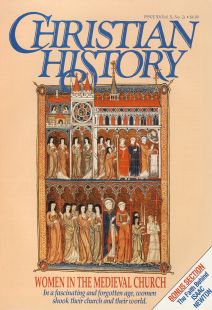Women in the Medieval Church: From the Editor — In the Middle (Ages) of a Debate
THREE YEARS AGO, Christian History published an issue devoted to women in the early church. That issue received more responses than almost any other issue in our history.
Some readers praised us for our open-mindedness. Others chastised us for our narrow-mindedness. No one seemed neutral. Gulp.
Such has been the case for two thousand years of church history. Early-church father Tertullian called women “the Devil’s gateway . . . the first forsaker of the divine law. . . . ” On the other hand, Jerome, another pillar of the early centuries, wrote: “Is it not to women that our Lord appeared after His Resurrection? Yes, and the men could then blush for not having sought what the women had found.”
In our own day, despite countless books, conferences, and theological debates, the role of women in the church is far from settled. Even in denominations that have taken a firm position, individual churches and women (and men) continue to wrestle with female ministry.
We hope to offer in this issue a neglected aspect of the debate: the role of women in the church during the medieval period (especially in Europe in the High Middle Ages). Please let us know what you think of these issues. Your opinions will help us to decide how, or whether, to continue the series.
The medieval era is surely one of the most difficult for us to understand. People danced around the Maypole, and built soaring cathedrals. They walked thousands of miles to view holy relics, and lit bonfires to ward off dragons. They illuminated some of the most beautiful books ever made, and fought plagues by carrying bouquets of flowers. They bathed in barrels, and saw visions of angels. And—impossible for us to understand—a massive Christendom ruled over all: kings and queens, abbots and abbesses, and countless peasant women and men.
Because the cultural differences are so great, it’s easy for us to question the faith of these believers 700 years (or more) ago. We like things rational and orderly, so their emphasis on mystical visions perplexes us. We emphasize the individual, so their stress on communal life makes us blink. We live in an age of The Playboy Channel, so their radical commitment to virginity strikes us as quaint.
Certainly not everything in the medieval church could or should be imitated. But before we dismiss the practices of these saints as misguided, we need to consider: Will Christians in the year 2690 see us as true believers?
By Kevin A. Miller
[Christian History originally published this article in Christian History Issue #30 in 1991]
Next articles
Catherine of Siena
Caroline T. MarshallTerms of the Religious Life
A glossary of terms relating to religious life of women in the Middle Ages.
the EditorsLife in a Medieval Village
From birth to death, a peasant woman’s difficult life intersected the church.
Frances and Joseph GiesInside the Convent
How did convents arise? Why did so many medieval women enter them?
Jo Ann McNamaraSupport us
Christian History Institute (CHI) is a non-profit Pennsylvania corporation founded in 1982. Your donations support the continuation of this ministry
Donate



